Theoretical and experimental validation of the aerosol electrical mobility separator electrometer
We have a new paper out in Aerosol Science and Technology: Theoretical and experimental validation of the aerosol electrical mobility separator electrometer , co-authored with the University of Cambridge.
The work shows modelling and validation of the Mobility Separator Electrometer (MSE), a key component of the Mass and Mobility Aerosol Spectrometer (M²AS).
The MSE is used in conjunction with another classifier such as an AAC or CPMA to provide additional electrical mobility ("size") information. It splits an aerosol into two streams, one greater than a certain electrical mobility and the other smaller, with the charge concentration in each stream then being determined by one of two faraday cup electrometers. It is usually used in a mode where the mobility setpoint is adjusted to keep the charge concentration in the two streams balanced such that the required setpoint gives the mid-point mobility of the aerosol pre-classified by the AAC or CPMA. It then "follows" the AAC or CPMA as they are scanned to give a simultaneous mobility measurement; the combination of classifiers yields further information such as density or charge.
Good agreement was seen between the modelled and measured transfer functions.
A tandem UDAC-AAC-MSE-CPC setup was used experimentally to measure the effective density of DOS and ammonium sulphate.
A follow-up paper will show characterisation of the complete M²AS system.
The work was undertaken as a result of our partnership with the EPSRC Centre for Doctoral Training in Aerosol Science.
